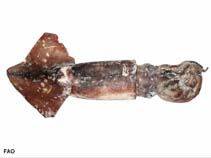Dosidicus gigas (D'Orbigny, 1835)
Jumbo flying squid| Native range | All suitable habitat | Point map | Year 2050 |

|
| This map was computer-generated and has not yet been reviewed. |
| Dosidicus gigas AquaMaps Data sources: GBIF OBIS |
Классификация / Names народные названия | синонимы | CoL | ITIS | WoRMS
Cephalopoda | Oegopsida | Ommastrephidae | Ommastrephinae
Environment: milieu / climate zone / пределы глубины / distribution range экология
пелагический; пределы глубины 0 - 1200 m (ссылка 1982). Tropical; 4°C - 32°C (ссылка 1982), preferred 26°C (ссылка 107945); 60°N - 53°S, 169°W - 70°W
Distribution страны | регионы FAO | Ecosystems | места находок | интродукции
Eastern Pacific. From south of Bering Strait to Gulf of Alaska, east to Gulf of California and south to Chile. Tropical to boreal.
Length at first maturity / Size / Weight / Возраст
половая зрелость: Lm 29.7 range ? - ? cm Max length : 400 cm TL самец/пол неопределен; (ссылка 275); common length : 80.0 cm TL самец/пол неопределен; (ссылка 275); наибольший вес (опубликованные данные): 3.0 kg (ссылка 275)
Life cycle and mating behavior половая зрелость | размножение | нерест | Eggs | Fecundity | Larvae
Основная ссылка
ссылки | координатор | соавторы
Roper, C.F.E., M.J. Sweeney and C.E. Nauen 1984 FAO Species Catalogue. Vol. 3. Cephalopods of the world. An annotated and illustrated catalogue of species of interest to fisheries. FAO Fish. Synop. 125(3):277p. Rome: FAO. (ссылка 275)
Статус Красного Списка МСОП
(ссылка 130435: Version 2025-1)
Статус СИТЕС (ссылка 108899)
CMS (ссылка 116361)
Угроза для людей
Использование человеком
рыболовство: коммерческий
FAO - рыболовство: landings, Видовой профиль | FishSource | Sea Around Us
инструменты
дополнительная информация
ресурсы в Интернет
BHL | BOLD Systems | CISTI | DiscoverLife | FAO(рыболовство: Видовой профиль; publication : search) | Fishipedia | GenBank (Геном, Нуклеотид) | GloBI | Gomexsi | Google Books | Google Scholar | Google | PubMed | Tree of Life | Wikipedia (Вперёд, поиск) | Zoological Record



